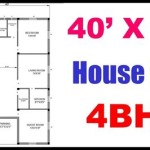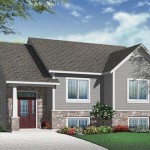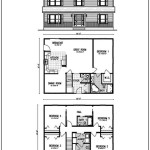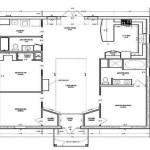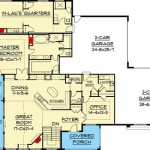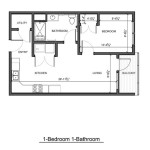```html
Home Plans With In-Law Suites: A Comprehensive Guide
The concept of multigenerational living is experiencing a resurgence, driven by factors such as rising housing costs, an aging population, and a desire for closer family connections. This trend has led to increased demand for home plans incorporating in-law suites, also known as accessory dwelling units (ADUs) or multigenerational suites. These suites offer a private living space within a larger home, providing independence for the occupants while maintaining proximity to family. Understanding the various aspects of in-law suite home plans is crucial for homeowners considering this option.
Defining the In-Law Suite
An in-law suite is generally understood as a self-contained living area within a larger, primary residence. Its defining characteristics typically include a private bedroom, bathroom, and living area. Crucially, it often also contains a kitchenette or full kitchen, allowing for independent meal preparation. The level of separation and independence can vary depending on the specific design and the needs of the occupants. Some in-law suites are fully integrated into the main house, sharing a common entrance and certain amenities. Others are designed with separate entrances, offering a greater sense of privacy and autonomy.
The term "in-law suite" is used broadly, and the specific features and design can be tailored to suit different family structures and living arrangements. For instance, the suite can be occupied by elderly parents, adult children returning home, or even long-term guests. The flexibility of the design is a key advantage, allowing the space to adapt to changing needs over time. Regardless of the specific arrangement, the primary goal is to provide a comfortable and private living space within the context of a shared family home.
Distinguishing an in-law suite from a simple guest room is important. While a guest room may offer a private bedroom and bathroom, it typically lacks the full kitchen or kitchenette that is characteristic of an in-law suite. This distinction is significant, as it impacts the level of independence the occupant has and influences the overall functionality of the space. The presence of cooking facilities fundamentally changes the nature of the living arrangement, allowing for self-sufficiency and reducing reliance on the main house for meals and other essential needs.
Key Considerations When Choosing an In-Law Suite Home Plan
Selecting the right in-law suite home plan involves careful consideration of several critical factors. These include the needs of the occupants, the overall aesthetics of the property, zoning regulations, and budgetary constraints. A thorough assessment of these aspects is essential to ensure that the chosen plan meets the specific requirements of the family and complies with all applicable legal requirements.
Occupant Needs:
The primary consideration should be the needs and preferences of the individuals who will be residing in the in-law suite. Factors such as mobility, health conditions, and lifestyle should inform the design choices. For elderly occupants, accessibility features such as grab bars in the bathroom, wider doorways for wheelchair access, and single-level living may be necessary. For younger occupants, a separate entrance, a designated workspace, and modern amenities may be more desirable. Understanding these needs is crucial for creating a comfortable and functional living space.Property Aesthetics and Integration:
The in-law suite should seamlessly integrate with the existing home's architecture and landscaping. A poorly designed addition can detract from the overall aesthetic appeal of the property and potentially reduce its value. Careful attention should be paid to matching the exterior materials, roofline, and window styles to ensure a cohesive look. The interior design should also complement the main house, creating a harmonious and unified living environment. Considerations such as natural light, ventilation, and privacy should also be addressed to maximize the comfort and livability of the suite.Zoning and Legal Requirements:
Prior to commencing any construction, it is essential to verify local zoning regulations and building codes pertaining to accessory dwelling units. Many municipalities have specific requirements regarding the size, location, and use of in-law suites. These regulations may restrict the number of occupants, require separate utility meters, or impose limitations on renting out the suite. Failure to comply with these regulations can result in fines, legal action, and even the forced removal of the unauthorized dwelling unit. Consulting with a local planning department and obtaining the necessary permits is a critical step in the process.Budgetary Constraints:
Developing a realistic budget is essential for managing the costs associated with building an in-law suite. Construction costs can vary significantly depending on the size, complexity, and materials used. It is important to obtain multiple quotes from qualified contractors and to factor in additional expenses such as architectural design fees, permit fees, and landscaping costs. Contingency funds should also be set aside to cover unexpected expenses that may arise during the construction process. Prioritizing essential features and making informed design choices can help to stay within budget without compromising the functionality and quality of the in-law suite.Different Types of In-Law Suite Home Plans
In-law suite home plans come in a variety of configurations, each offering distinct advantages and disadvantages. The best type of plan for a particular family will depend on their specific needs, preferences, and the characteristics of their property. Understanding the different types of plans available is essential for making an informed decision.
Attached In-Law Suites:
Attached in-law suites are the most common type of plan, typically located on the first floor of the main house and sharing a common wall. These suites can have a separate entrance or share the main entrance with the primary residence. A key advantage of attached suites is their easy accessibility and integration with the main house, making them ideal for elderly parents or individuals with mobility limitations. However, attached suites may offer less privacy than detached suites, as they are directly connected to the main living area. Noise transmission can also be a concern, requiring careful attention to soundproofing during construction.Detached In-Law Suites (Accessory Dwelling Units):
Detached in-law suites, also known as accessory dwelling units (ADUs), are separate structures located on the same property as the main house. These suites offer the highest level of privacy and independence, as they function as self-contained living units. Detached ADUs can be built above a garage, in a backyard, or as a standalone structure. A major advantage of detached suites is their ability to be rented out as separate units, providing a potential source of income for the homeowner. However, detached ADUs can be more expensive to build than attached suites, as they require separate utility connections and may be subject to more stringent zoning regulations.Basement In-Law Suites:
Basement in-law suites involve converting an existing basement into a self-contained living area. This option can be more cost-effective than building a new addition, as the foundation and structural elements are already in place. However, basement suites may have limitations in terms of natural light and ventilation, requiring careful attention to these aspects during the design process. Egress windows are also essential for ensuring safety and complying with building codes. Basement suites can be a good option for families looking to maximize their existing space and create a comfortable and private living area for in-laws or other family members.Above-Garage In-Law Suites:
Constructing an in-law suite above an existing or new garage is another popular option. This approach offers a balance between privacy and accessibility, as the suite is separate from the main house but still conveniently located on the property. Above-garage suites typically have their own entrance and staircase, providing a sense of independence for the occupants. However, access to the suite may be a concern for individuals with mobility limitations. Careful planning is also required to ensure that the garage structure can support the weight of the additional living space.The selection of an in-law suite home plan represents a significant decision. Understanding the specific needs of the occupants, navigating zoning regulations, and considering the various types of plans available are all critical steps in creating a successful and harmonious multigenerational living arrangement.
```
Southern Style House Plan With In Law Suite

House Plan 65862 Tuscan Style With 2091 Sq Ft 3 Bed 2 Bath 1

In Law Suite Plans Give Mom Space And Keep Yours The House Designers

House Plans With In Law Suites Houseplans Blog Com

House Plans With In Law Suites Houseplans Blog Com

Exquisite Mountain Modern Home Plan With In Law Suite And 4 Car Garage 95104rw Architectural Designs House Plans

Country House Plan With 4 Bedrooms And 3 5 Baths 4427

House Plans With In Law Suites Houseplans Blog Com

Pin On Dream Home

Front Side View House Plans With A Separate In Law Suite


